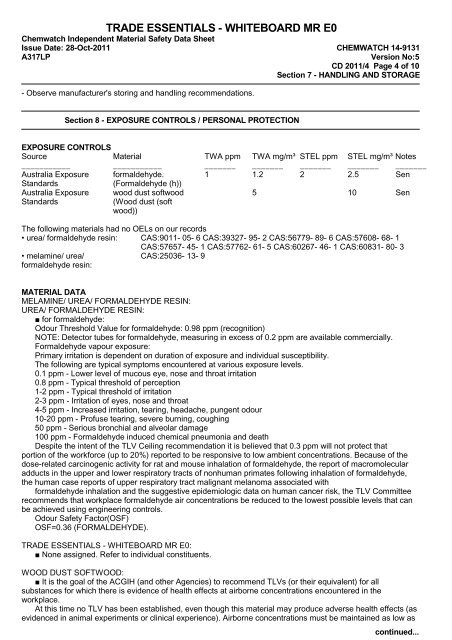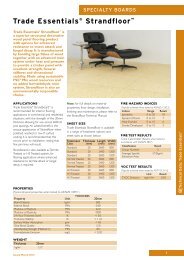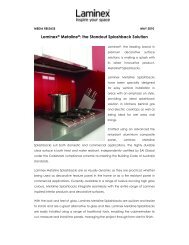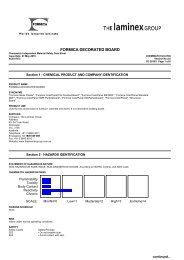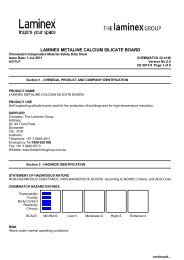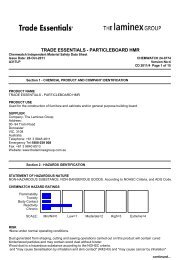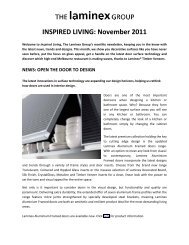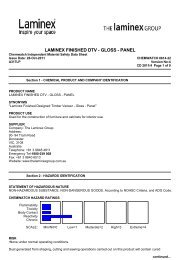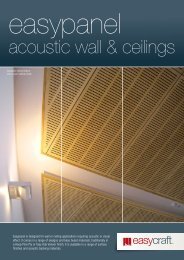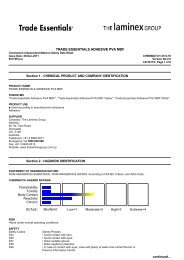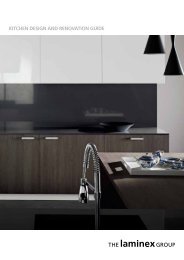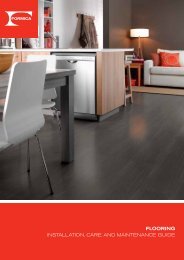Trade Essentials Whiteboard MR E0 MSDS 14-9131 - The Laminex ...
Trade Essentials Whiteboard MR E0 MSDS 14-9131 - The Laminex ...
Trade Essentials Whiteboard MR E0 MSDS 14-9131 - The Laminex ...
Create successful ePaper yourself
Turn your PDF publications into a flip-book with our unique Google optimized e-Paper software.
TRADE ESSENTIALS - WHITEBOARD <strong>MR</strong> <strong>E0</strong>Chemwatch Independent Material Safety Data SheetIssue Date: 28-Oct-2011 CHEMWATCH <strong>14</strong>-<strong>9131</strong>A317LPVersion No:5CD 2011/4 Page 4 of 10Section 7 - HANDLING AND STORAGE- Observe manufacturer's storing and handling recommendations.Section 8 - EXPOSURE CONTROLS / PERSONAL PROTECTIONEXPOSURE CONTROLSSource Material TWA ppm TWA mg/m³ STEL ppm STEL mg/m³ Notes___________ ___________ _______ _______ _______ _______ _______Australia Exposure formaldehyde. 1 1.2 2 2.5 SenStandards(Formaldehyde (h))Australia Exposure wood dust softwood 5 10 SenStandards(Wood dust (softwood))<strong>The</strong> following materials had no OELs on our records• urea/ formaldehyde resin: CAS:9011- 05- 6 CAS:39327- 95- 2 CAS:56779- 89- 6 CAS:57608- 68- 1CAS:57657- 45- 1 CAS:57762- 61- 5 CAS:60267- 46- 1 CAS:60831- 80- 3• melamine/ urea/ CAS:25036- 13- 9formaldehyde resin:MATERIAL DATAMELAMINE/ UREA/ FORMALDEHYDE RESIN:UREA/ FORMALDEHYDE RESIN:■ for formaldehyde:Odour Threshold Value for formaldehyde: 0.98 ppm (recognition)NOTE: Detector tubes for formaldehyde, measuring in excess of 0.2 ppm are available commercially.Formaldehyde vapour exposure:Primary irritation is dependent on duration of exposure and individual susceptibility.<strong>The</strong> following are typical symptoms encountered at various exposure levels.0.1 ppm - Lower level of mucous eye, nose and throat irritation0.8 ppm - Typical threshold of perception1-2 ppm - Typical threshold of irritation2-3 ppm - Irritation of eyes, nose and throat4-5 ppm - Increased irritation, tearing, headache, pungent odour10-20 ppm - Profuse tearing, severe burning, coughing50 ppm - Serious bronchial and alveolar damage100 ppm - Formaldehyde induced chemical pneumonia and deathDespite the intent of the TLV Ceiling recommendation it is believed that 0.3 ppm will not protect thatportion of the workforce (up to 20%) reported to be responsive to low ambient concentrations. Because of thedose-related carcinogenic activity for rat and mouse inhalation of formaldehyde, the report of macromolecularadducts in the upper and lower respiratory tracts of nonhuman primates following inhalation of formaldehyde,the human case reports of upper respiratory tract malignant melanoma associated withformaldehyde inhalation and the suggestive epidemiologic data on human cancer risk, the TLV Committeerecommends that workplace formaldehyde air concentrations be reduced to the lowest possible levels that canbe achieved using engineering controls.Odour Safety Factor(OSF)OSF=0.36 (FORMALDEHYDE).TRADE ESSENTIALS - WHITEBOARD <strong>MR</strong> <strong>E0</strong>:■ None assigned. Refer to individual constituents.WOOD DUST SOFTWOOD:■ It is the goal of the ACGIH (and other Agencies) to recommend TLVs (or their equivalent) for allsubstances for which there is evidence of health effects at airborne concentrations encountered in theworkplace.At this time no TLV has been established, even though this material may produce adverse health effects (asevidenced in animal experiments or clinical experience). Airborne concentrations must be maintained as low ascontinued...


